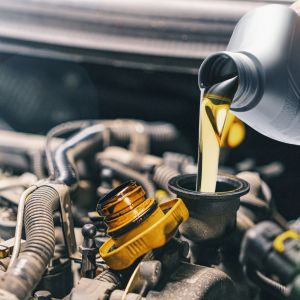Your car’s engine oil level is the heart of its performance, and just like the human heart, it requires proper care to function at its best. One crucial aspect of engine maintenance is regularly checking the oil level. Engine oil is the lifeblood of your vehicle, lubricating crucial components and ensuring smooth operation. In this comprehensive guide, we’ll walk you through the step-by-step process of checking your car’s engine oil level, empowering you to take control of your vehicle’s health.
Why Checking Engine Oil Level Matters

Before diving into the how-tos, let’s understand why regularly checking your car’s engine oil is essential. Engine oil lubricates moving parts, reduces friction, and helps dissipate heat generated during combustion. Insufficient oil levels can lead to increased friction, overheating, and eventually, engine damage. By making oil level checks a routine part of your vehicle maintenance, you can detect potential issues early, ensuring a longer and healthier life for your car.
When to Check: Timing is Everything in Engine Oil Maintenance

The frequency of checking your engine oil depends on various factors, including the type of oil your car uses, its age, and your driving habits. As a general rule of thumb, it’s advisable to check your oil at least once a month and before long journeys. Additionally, if you notice any warning lights on your dashboard or experience unusual engine sounds, don’t hesitate to check the oil level promptly.
Step-by-Step Guide: How to Check Your Car’s Engine Oil Like a Pro
1. Park on a Level Surface: Setting the Stage for Accurate Measurements
Before popping the hood, ensure your car is parked on a level surface. This step is crucial for obtaining accurate oil level readings. Parking on an incline can result in false measurements, leading to incorrect assessments of your engine oil level.
2. Allow the Engine to Cool: Safety First
To get an accurate reading, it’s essential to let the engine cool down. Running the engine increases oil circulation, and checking the level immediately after turning off the car may provide inaccurate results. Wait for a few minutes to allow the oil to settle back into the oil pan.
3. Locate the Dipstick: Your Key to Engine Oil Insights
The dipstick is a slender, often brightly colored rod located near the engine. It’s your primary tool for checking the oil level. Gently pull the dipstick out and wipe it clean with a cloth. This ensures that the reading is not contaminated by old oil or debris.
4. Reinsert and Withdraw the Dipstick: Reading Between the Lines
Insert the clean dipstick back into its tube and push it all the way in. After a moment, pull it out again and examine the oil level. The dipstick usually has two marks – a low mark and a high mark. The oil level should fall between these two indicators. If it’s below the minimum mark, it’s time to add oil.
5. Assess the Oil’s Condition: Quality Check
While checking the oil level, take a moment to inspect its color and consistency. Healthy engine oil is amber in color and has a smooth texture. Dark, gritty, or sludgy oil may indicate contaminants or the need for an oil change.
Beyond the Basics: Understanding Oil Types and Additional Tips

Choosing the Right Oil: A Matter of Specifications
Understanding your car’s oil requirements is crucial. Refer to your vehicle’s manual to determine the recommended oil type and viscosity. Using the wrong oil can adversely affect engine performance and longevity.
Top-up with Caution: Don’t Overfill
If the oil level is below the minimum mark, it’s time to add oil. Use a funnel to avoid spills, and add a small amount at a time, checking the level frequently. Overfilling can be as harmful as low oil levels, potentially causing engine damage.
Regular Oil Changes: Prolonging Engine Life
Checking the oil level is only part of the equation. Regular oil changes are vital for maintaining a healthy engine. Follow the manufacturer’s recommendations for oil change intervals, considering factors like driving conditions and mileage.
Identifying Warning Signs: Addressing Potential Problems
While checking the engine oil level, pay attention to any warning signs that could indicate underlying issues. These may include a burnt oil smell, foamy consistency on the dipstick, or metal particles in the oil. If you notice any of these signs, it’s advisable to consult with a professional mechanic for a more in-depth inspection.
Understanding Oil Leaks: A Closer Look at Possible Culprits
If you find a consistent drop in your engine oil level between regular checks, it could be a sign of an oil leak. Common areas for leaks include the oil pan gasket, valve cover gasket, or the oil filter. Addressing leaks promptly is crucial to prevent damage to the engine and ensure a constant oil supply.
Oil Level Fluctuations: Normal vs. Abnormal
It’s normal for oil levels to fluctuate slightly between oil changes. Factors such as temperature, engine load, and driving conditions can influence oil consumption. However, a sudden and significant drop in oil level may indicate a more serious problem, such as burning oil or a leak. Regular monitoring helps you distinguish between normal variations and potential issues.
Advanced Tips for Engine Oil Maintenance

- Oil Quality Matters: Invest in high-quality oil that meets your car manufacturer’s specifications. Premium oils often contain additives that provide better protection against wear and deposits.
- Check Oil When Cold: For a more accurate reading, check your oil level when the engine is cold. This allows the oil to settle in the oil pan, providing a true representation of the oil level.
- Keep a Record: Maintain a log of your oil checks and changes. This record can be valuable for identifying patterns or trends in oil consumption and engine performance over time.
- Consider Synthetic Oils: Synthetic oils offer enhanced protection and performance compared to conventional oils. While they may be pricier, their benefits, including better temperature stability and reduced friction, make them a worthy investment.
- Consult Your Mechanic: If you’re unsure about any aspect of your engine oil maintenance, don’t hesitate to consult with a professional mechanic. They can provide guidance on oil types, change intervals, and address any specific concerns about your vehicle.
Understanding Oil Viscosity: Tailoring Your Oil Choice
Engine oil viscosity, often denoted by numbers like 10W-30 or 5W-40, plays a crucial role in lubrication. The first number (e.g., 10W) indicates the oil’s flowability in cold temperatures, while the second number (e.g., 30 or 40) represents viscosity at operating temperatures. Choosing the right viscosity for your climate and driving conditions ensures optimal lubrication across a range of temperatures.
Oil Analysis: A Proactive Approach to Engine Health
For enthusiasts or those truly dedicated to their vehicle’s longevity, oil analysis is a powerful tool. This involves sending a small sample of your engine oil to a laboratory for examination. The analysis can reveal insights into engine wear, contamination levels, and the overall health of your engine. While it may seem like an advanced step, it provides valuable data for fine-tuning your maintenance routine.
The Role of Oil Filters: Maximizing Engine Protection
In addition to checking the oil level, regularly inspect and replace the oil filter. The oil filter is responsible for trapping contaminants and preventing them from circulating through the engine. A clogged or ineffective filter compromises the quality of lubrication, potentially leading to accelerated engine wear. Follow your vehicle manufacturer’s recommendations for oil filter replacement intervals.
Environmental Considerations: Eco-Friendly Oil Disposal
Proper disposal of used engine oil is a critical aspect of responsible car ownership. Never discard used oil in the trash, down drains, or on the ground. Many auto parts stores and recycling centers accept used oil for recycling. Some municipalities also have designated collection points. By disposing of oil responsibly, you contribute to environmental preservation and comply with regulations.
DIY Engine Oil Change: Taking Control of Your Maintenance
While checking the engine oil level is a routine task, changing the oil is a more involved but equally important maintenance activity. Doing it yourself not only saves money but also gives you a deeper understanding of your vehicle. Ensure you have the right tools, oil filter, and, most importantly, the correct type and amount of oil. Follow your car’s manual for step-by-step instructions on the oil change process.
Conclusion
In conclusion, checking your car’s engine oil level is a simple yet powerful way to ensure the longevity and optimal performance of your vehicle. By understanding the importance of engine oil, knowing when to check, and following the step-by-step guide, you can take proactive measures in maintaining your car’s health. Remember, a few minutes spent on this routine task can save you from costly repairs and keep your car running smoothly for years to come. Take charge of your vehicle’s well-being, and it will reward you with a reliable and enduring performance on the road.

